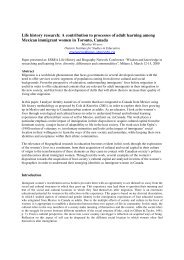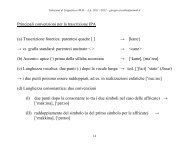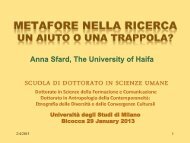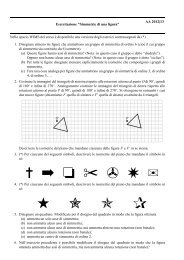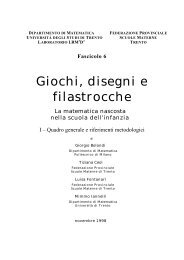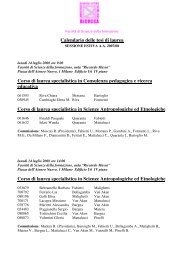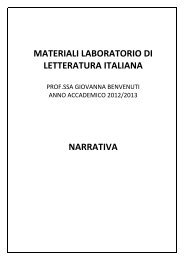Natural Semantic Metalanguage - Scienze della Formazione
Natural Semantic Metalanguage - Scienze della Formazione
Natural Semantic Metalanguage - Scienze della Formazione
Create successful ePaper yourself
Turn your PDF publications into a flip-book with our unique Google optimized e-Paper software.
Linguistica applicata<br />
<strong>Semantic</strong>a e pragmatica in<br />
prospettiva interculturale<br />
Parte sesta – Universali semantici,<br />
traducibilità, cultural scripts: il<br />
<strong>Natural</strong> <strong>Semantic</strong> <strong>Metalanguage</strong> di<br />
Anna Wierzbicka e Cliff Goddard
Introduzione: il problema <strong>della</strong><br />
“traducibilità” dei significati<br />
--- Se nella semantica e nella cognizione si possono identificare sia<br />
aspetti universali che aspetti language-specific e culture-specific, si<br />
pone il problema di quanto siano “trasponibili” i concetti e i<br />
significati da una lingua all’altra.<br />
--- Due posizioni opposte:<br />
1) significati e concetti NON possono essere trasposti da una<br />
lingua all’altra se non a costo di gravi perdite di “specificità” e<br />
imprecisioni;<br />
2) esiste un nucleo di concetti universali, che possono essere<br />
espressi linguisticamente con strategie “semplici” in tutte le<br />
lingue, e che garantiscono, se non la traducibilità, almeno la<br />
possibilità di parafrasare concetti language-specific e culturespecific<br />
in una lingua diversa.
Il <strong>Natural</strong> <strong>Semantic</strong> <strong>Metalanguage</strong> (NSM)<br />
--- La posizione 2) è incarnata dall’approccio noto come <strong>Natural</strong><br />
<strong>Semantic</strong> <strong>Metalanguage</strong>, sviluppato da Anna Wierzbicka e Cliff<br />
Goddard, che mira a salvaguardare la specificità culturale dei<br />
significati e, al tempo stesso, propone un sistema universale di<br />
rappresentazione degli stessi basato sull’individuazione di:<br />
a) un nucleo di primitivi semantici;<br />
b) un insieme di regole di spiegazione semantica (semantic<br />
explications) che combinano insieme i primitivi e permettono di<br />
rendere conto dei significati language-specific di parole e costruzioni<br />
grammaticali;<br />
c) una insieme di cultural scripts che permettono di rendere conto dei<br />
valori e delle attitudini culture-specific connesse ai significati delle<br />
parole.
Il <strong>Natural</strong> <strong>Semantic</strong> <strong>Metalanguage</strong><br />
L’assunto di base del NSM è che i significati<br />
delle parole complesse possono essere definiti<br />
utilizzando parole più semplici da<br />
comprendere: queste parole più semplici<br />
costituiscono i primitivi semantici, concetti<br />
irriducibili ad altri concetti, che si combinano<br />
insieme, seguendo una grammatica specifica, in<br />
espressioni complesse che rappresentano delle<br />
“parafrasi riduttive” (reductive paraphrases)<br />
dei significati complessi.
Il <strong>Natural</strong> <strong>Semantic</strong> <strong>Metalanguage</strong><br />
Un esempio: il significato del verbo kill
Il <strong>Natural</strong> <strong>Semantic</strong> <strong>Metalanguage</strong><br />
Un esempio: il significato del verbo break
Il <strong>Natural</strong> <strong>Semantic</strong> <strong>Metalanguage</strong><br />
Un esempio: il significato dell’aggettivo<br />
envious:
Il <strong>Natural</strong> <strong>Semantic</strong> <strong>Metalanguage</strong><br />
These explications should underscore the point that<br />
although the NSM approach can be seen as a classical<br />
approach to semantics in some respects, especially in its<br />
commitment to semantic description in discrete<br />
propositional terms, it is quite unlike other so-called<br />
classical approaches to semantics. First, NSM explications<br />
are not lists of necessary conditions, or bundles of<br />
semantic features. They are essentially texts composed in a<br />
specified minimal subset of ordinary language. Second, the<br />
NSM approach is not linked in any way with so-called<br />
“objectivism”, i.e., the view that linguistic expressions get<br />
their meaning from correspondences with aspects of an<br />
objective, language-independent reality…
Il <strong>Natural</strong> <strong>Semantic</strong> <strong>Metalanguage</strong><br />
… On the contrary, the proposed NSM metalanguage<br />
contains sundry elements which are inherently<br />
subjective, vague, and evaluational (such as, for<br />
example, LIKE and GOOD). Third, it is entirely<br />
possible to incorporate conceptual prototypes,<br />
scenarios, and so on, within NSM explications<br />
(C. Goddard, 2002. The search for the shared semantic<br />
core of all languages. In C. Goddard & A. Wierzbicka<br />
(eds). Meaning and Universal Grammar - Theory and<br />
Empirical Findings. Volume I. Amsterdam: John<br />
Benjamins. p. 8)
Il <strong>Natural</strong> <strong>Semantic</strong> <strong>Metalanguage</strong><br />
I primitivi semantici sono concetti semplici ed<br />
intuitivamente intellegibili, che hanno un fondamento<br />
nell’esperienza quotidiana di ciascun parlante, e che<br />
non possono a loro volta essere ridotti a altri significati<br />
semplici.<br />
Ciascun primitivo semantico ha un insieme di<br />
proprietà sintattiche che servono a combinarlo con<br />
altri primitivi, formando una sorta di mini-linguaggio<br />
con le sue regole grammaticali, che è alla base delle<br />
parafrasi riduttive come quella dei verbi kill e break e<br />
dell’aggettivo envious, e che può essere utilizzato per<br />
“parafrasare” tutti i significati complessi.
Il <strong>Natural</strong> <strong>Semantic</strong> <strong>Metalanguage</strong>
Il <strong>Natural</strong> <strong>Semantic</strong> <strong>Metalanguage</strong><br />
I primitivi semantici possono essere concepiti come<br />
universali lessicali (cioè lessemi presenti in tutte le lingue<br />
del mondo), purché si dia a “lessicale” un significato<br />
ampio: i significati <strong>della</strong> tabella precedente non devono<br />
essere necessariamente realizzati da “parole” in ogni<br />
lingua, ma possono essere realizzati da “frasemi” (unità<br />
più ampie di una singola parola, sintagmi) o da morfemi<br />
(unità inferiori a una singola parola). Ad esempio in<br />
inglese un primitivo semantico come a long time è<br />
espresso da un frasema, mentre il primitivo semantico<br />
because prende la forma di un suffisso (-nguru) nella<br />
lingua australiana yankunytjatjara (e in molte altre lingue<br />
australiane).
Il <strong>Natural</strong> <strong>Semantic</strong> <strong>Metalanguage</strong><br />
--- Come si individua un primitivo semantico?<br />
Secondo Wierzbicka e Goddard è essenziale<br />
adottare dei criteri rigorosi per mostrare che un<br />
dato concetto è un primitivo semantico. Il primo<br />
criterio è quello <strong>della</strong> sua “irriducibilità” ad<br />
altri concetti.<br />
--- Prendiamo il verbo say: come possiamo<br />
definire il significato di questo verbo e come<br />
facciamo a stabilire che si tratta di un primitivo<br />
semantico?
Il <strong>Natural</strong> <strong>Semantic</strong> <strong>Metalanguage</strong><br />
--- Una definizione da dizionario (ad es. verbally express<br />
sth) non funziona, perché utilizza termini più complessi del<br />
termine da definire;<br />
--- una frase come Mary said something potrebbe essere<br />
parafrasata, utilizzando altri primitivi semantici, nel modo<br />
seguente: Mary did something, because she wanted me to<br />
know something; anche questa parafrasi però non funziona,<br />
perché le azioni che si possono compiere perché si vuole<br />
informare qualcuno di qualcosa sono molte, e quindi say<br />
non è l’unico concetto che soddisfa la parafrasi;<br />
Conclusione: say è un primitivo semantico perché è<br />
irriducibile ad altri concetti. Ma non basta…
Il <strong>Natural</strong> <strong>Semantic</strong> <strong>Metalanguage</strong><br />
“The challenge consists not in proposing a list of candidates, but in<br />
justifying it.” (Wierzbicka 1992: 11)<br />
Criteri:<br />
(1) irriducibilità ad altri concetti (v. sopra);<br />
(2) ruolo di un concetto nel definire altri concetti;<br />
(3) criterio “cross-linguistico”:<br />
a) candidates for the status of innate and universal human<br />
concepts should ‘prove themselves’ in extensive descriptive<br />
work involving many different languages of the world<br />
(genetically and culturally distant from one another);<br />
b) the concepts which have ‘proved themselves’ as building<br />
blocks in definitions should also prove themselves as lexical<br />
universals, that is, as concepts which have their own<br />
‘names’ in all the languages of the world (Wierzbicka 1992:<br />
12)
Il <strong>Natural</strong> <strong>Semantic</strong> <strong>Metalanguage</strong><br />
In quanto primitivo semantico, say può essere<br />
utilizzato per parafrasare altre parole, come ask,<br />
criticize, apologize, demand, ecc.:<br />
Mary asked me something<br />
Parafrasi: Mary said something to me,<br />
because she wanted to know<br />
something;<br />
she wanted me to say something<br />
because of this.
Il <strong>Natural</strong> <strong>Semantic</strong> <strong>Metalanguage</strong><br />
--- Il significato di say è necessario per definire un<br />
ampio insieme di altri significati (ask, persuade,<br />
apologize, curse ecc.); lo stesso non si può dire, ad<br />
esempio, del significato lessicalizzato nel verbo<br />
inglese persuade;<br />
--- Il significato di say è notoriamente presente, come<br />
parola indipendente o come morfema, in tutte le<br />
lingue del mondo (non esistono lingue che non<br />
abbiano un modo semplice di veicolare il significato<br />
say, mentre esistono lingue che non hanno un modo<br />
semplice di veicolare il significato persuade).
Un problema: la polisemia<br />
Due problemi specifici che nascono nell’individuazione dei<br />
primitivi semantici sono connessi alla polisemia:<br />
(i) quando si cercano nelle lingue del mondo le parole che<br />
incarnano i primitivi semantici, non è sempre facile<br />
capire se le parole individuate hanno come significato<br />
primario quello che corrisponde al primitivo semantico<br />
o un altro significato;<br />
(ii) i primitivi semantici sono identificati con termini<br />
dell’inglese, ma in linea di principio potrebbero essere<br />
espressi in qualsiasi lingua; dato che alcune delle<br />
parole inglesi utilizzate sono polisemiche, è opportuno<br />
specificare quale dei tanti significati <strong>della</strong> parola<br />
inglese utilizzata rappresenta un primitivo semantico.
Un problema: la polisemia<br />
Per affrontare il primo problema i teorici del NSM hanno predisposto<br />
delle liste di polisemie frequenti che coinvolgono gli universali<br />
lessicali: quando in una lingua troviamo un termine che presenta un<br />
tipo di polisemia come quelli attestati nella tabella seguente,<br />
possiamo essere sicuri che il significato di base del termine è quello<br />
che coincide con il primitivo semantico che si sta cercando di<br />
identificare:
Un problema: la polisemia<br />
Il secondo problema si risolve specificando esattamente il significato<br />
dei primitivi semantici attraverso una sorta di mini-grammatica che<br />
specifica in quali contesti questi termini possono comparire:
NSM: applicazioni<br />
La descrizione del significato attraverso i primitivi semantici si<br />
complica quando si descrive il significato di termini più complessi<br />
come quelli che indicano emozioni e sentimenti (joy, remorse, sad,<br />
ecc.). Prendiamo il caso di sad:
NSM: applicazioni<br />
La “spiegazione<br />
riduttiva” del<br />
significato di sad<br />
attraverso i<br />
primitivi<br />
semantici può<br />
sembrare<br />
semplicistica,<br />
eppure è in<br />
grado di cogliere<br />
le differenze di<br />
significato sottili<br />
tra sad e<br />
unhappy
NSM: applicazioni
NSM: applicazioni<br />
Attraverso le spiegazioni riduttive si<br />
possono cogliere anche le variazioni di<br />
significato di un termine nel corso del<br />
tempo. Ad esempio si può definire friend<br />
nel suo significato attuale, e nel<br />
significato che il termine aveva nella<br />
letteratura settecentesca e romantica, in<br />
cui designava un legame affettivo più<br />
vicino all’amore.
NSM: applicazioni<br />
Friend (present-day English)<br />
I think about this person like this:<br />
I know this person well<br />
when I do things with this person, I feel something good<br />
when I am with this person, I feel something<br />
good<br />
I know that this person thinks the same about me<br />
***<br />
Friend (18 th and 19 th century English)<br />
I think about this person like this:<br />
I know this person well<br />
when I do things with this person, I feel something good<br />
when I am with this person, I feel something<br />
good<br />
I know that this person thinks the same about me<br />
I want this person to know how I feel<br />
I want this person to know what I think about things<br />
I want to do good things for this person
NSM: le “molecole” semantiche<br />
Secondo i teorici del NSM, alcuni concetti (come quelli<br />
che riguardano le emozioni, i sentimenti) sono<br />
semanticamente più semplici di altri concetti perché<br />
possono essere definiti utilizzando esclusivamente<br />
primitivi semantici, mentre altri concetti (ad esempio<br />
quelli relativi agli animali o ai manufatti) richiedono un<br />
passaggio in più. Questo passaggio in più richiede<br />
quelle che i teorici del NSM chiamano “molecole<br />
semantiche”.<br />
Le molecole semantiche sono definite come<br />
“concetti di secondo livello”, oppure come “packets of<br />
semantic components that exist as meanings of lexical<br />
units”
NSM: le “molecole” semantiche<br />
Un esempio di molecola semantica: make
NSM: le “molecole” semantiche<br />
Un esempio di molecola semantica: animal
NSM: le “molecole” semantiche<br />
Un esempio di molecola semantica (animal) utilizzata<br />
nella spiegazione riduttiva di un concetto (cat)<br />
…
NSM: le “molecole” semantiche<br />
Le “molecole” semantiche più tipiche<br />
includono:<br />
• body-part terms (hands, head, ears,<br />
eyes, mouth, hairs, fur, feet, tail, claws)<br />
• physical descriptors of various kinds<br />
(long, round, pointed, sticking out, soft,<br />
stiff, sharp, shiny)<br />
• bodily actions and postures (eat, climb,<br />
jump, fight, etc.)
NSM in prospettiva interculturale<br />
The metalanguage of semantic primes can be used not only for<br />
lexical and grammatical semantics, but also as a notation for<br />
writing cultural scripts, that is, hypotheses about culturally<br />
shared assumptions, norms, and expectations that help regulate<br />
interaction in different cultural settings. By using simple crosstranslatable<br />
expressions, this approach to cultural pragmatics (or<br />
ethno-pragmatics) avoids the implicit terminological<br />
ethnocentrism of conventional approaches that rely on complex<br />
technical and/or English-specific descriptors. Cultural scripts<br />
written in semantic primes aim to present an insider perspective<br />
on cultural norms in terms that are accessible to outsiders. The<br />
NSM metalanguage can also be used to spell out the meanings<br />
conveyed by nonverbal signals, such as facial expressions,<br />
gestures, and body postures (C. Goddard, “<strong>Natural</strong> <strong>Semantic</strong><br />
<strong>Metalanguage</strong>”, in K. Brown [ed.] 2006, Encyclopedia of<br />
Language and Linguistics)
NSM in prospettiva interculturale<br />
Un esempio:<br />
someone X lied to someone Y:<br />
someone X said something to someone else Y<br />
this someone knew that it was not true<br />
this someone said it because he/she wanted this<br />
other someone to think that it was true<br />
people think that it is bad if someone does<br />
something like this<br />
Questa parafrasi riduttiva di lie è in grado di<br />
incorporare gli elementi culture-specific e gli aspetti<br />
“valutativi” del concetto lie.
NSM in prospettiva interculturale<br />
Un altro esempio: il concetto giapponese di amae<br />
someone X feels amae (towards Y) at this time:<br />
someone X thinks like this at this time (about<br />
someone Y):<br />
“this someone can do good things for<br />
me<br />
this someone wants to do good things<br />
for me<br />
when I am with this someone, nothing<br />
bad can happen to me<br />
I want to be with this someone”<br />
because of this, this someone feels something good<br />
at this time<br />
like someone can feel when they think like this
NSM in prospettiva interculturale<br />
Le definizioni dei dizionari bilingui di amae sono estremamente<br />
più imprecise e generiche:<br />
to lean on a person’s good will<br />
to depend on another’s affection<br />
to act lovingly towards<br />
to presume upon<br />
to take advantage of<br />
to behave like a spoilt child<br />
be coquettish<br />
trespass-on<br />
take advantage of<br />
behave in a caressing manner towards a man<br />
to speak in a coquettish tone<br />
encroach on (one’s kindness, good nature, etc.)<br />
presume on another’s love<br />
coax
NSM in prospettiva interculturale: i<br />
cultural scripts<br />
I primitivi semantici possono essere utilizzati anche per<br />
quelli che Goddard e Wierzbicka chiamano cultural<br />
scripts:<br />
“Cultural scripts” are a way of spelling out different<br />
“local” conventions of discourse using the<br />
metalanguage of universal semantic primes. Using this<br />
method, cultural norms can be spelt out with much<br />
greater precision than is possible with technical labels<br />
such as “direct”, “polite”, “formal” and so on.<br />
Because they are phrased in simple and translatable<br />
terms, the danger of ethnocentric bias creeping into the<br />
very terms of the description is minimised.
NSM in prospettiva interculturale: i<br />
cultural scripts<br />
Cultural scripts are not intended to provide an account<br />
of real life social interactions. Rather they are<br />
intended as descriptions of commonly held assumptions<br />
about how “people think” about social interaction.<br />
Because people bring these assumptions with them into<br />
everyday interactions, cultural scripts influence the<br />
form taken by particular verbal encounters but they do<br />
not in any sense determine individual interactions.<br />
Individuals can and do vary in their speech behaviour.<br />
The claim of the cultural scripts approach is merely<br />
that the scripts form a kind of interpretive background<br />
against which individuals position their own acts and<br />
those of others. (dalla <strong>Natural</strong> <strong>Semantic</strong> <strong>Metalanguage</strong><br />
Homepage, www.une.edu.au/bcss/linguistics/nsm/)
NSM in prospettiva interculturale: i<br />
cultural scripts<br />
Un esempio di cultural script relativo alla cultura<br />
giapponese (per quanto non sia esclusivo di<br />
quest’ultima), che spiega la tendenza tipica dei<br />
giapponesi a scusarsi di continuo:<br />
many people think like this:<br />
many people think like this:<br />
when something bad happens to someone because I did<br />
something,<br />
I have to (= can’t not) say something like this to this<br />
someone:<br />
“I feel something bad because of this”<br />
I have to (= can’t not) do something because of<br />
this
NSM in prospettiva interculturale: i<br />
cultural scripts<br />
Un altro esempio di cultural script relativo alla<br />
cultura anglosassone, che ha a che fare con il<br />
concetto di autonomia personale e libertà<br />
decisionale:<br />
many people think like this:<br />
when someone does something, it is<br />
good if this someone can think like this:<br />
“I am doing this because I want to<br />
do it”
NSM in prospettiva interculturale: i<br />
cultural scripts<br />
Qual è l’utilità dei cultural scripts?<br />
--- In primo luogo, permettono di descrivere un<br />
comportamento o una norma tipici di una cultura in<br />
maniera molto più dettagliata di quanto sarebbe possibile<br />
utilizzando, ad esempio, un verbo come scusarsi o<br />
apologize.<br />
--- In secondo luogo, mentre apologize implica<br />
l’ammissione di aver compiuto qualcosa di negativo, il<br />
cultural script specifica che non è l’aver compiuto<br />
qualcosa di negativo, come avviene ad esempio nella<br />
cultura anglosassone, a spingere il parlante giapponese a<br />
“scusarsi”, ma la percezione che il proprio<br />
comportamento possa creare danno all’interlocutore.
NSM in prospettiva interculturale: i<br />
cultural scripts<br />
Qual è l’utilità dei cultural scripts?<br />
--- Inoltre, è opportuno ricordare che i cultural<br />
scripts non sono modelli a cui i parlanti di una<br />
data lingua sono “obbligati” a adeguarsi. Essi<br />
possono anche essere messi in dubbio,<br />
sovvertiti, sfidati: quello che importa è che<br />
“whether or not cultural scripts are being<br />
followed in behavioural terms, however, the<br />
claim is that they constitute a kind of shared<br />
interpretive background”



